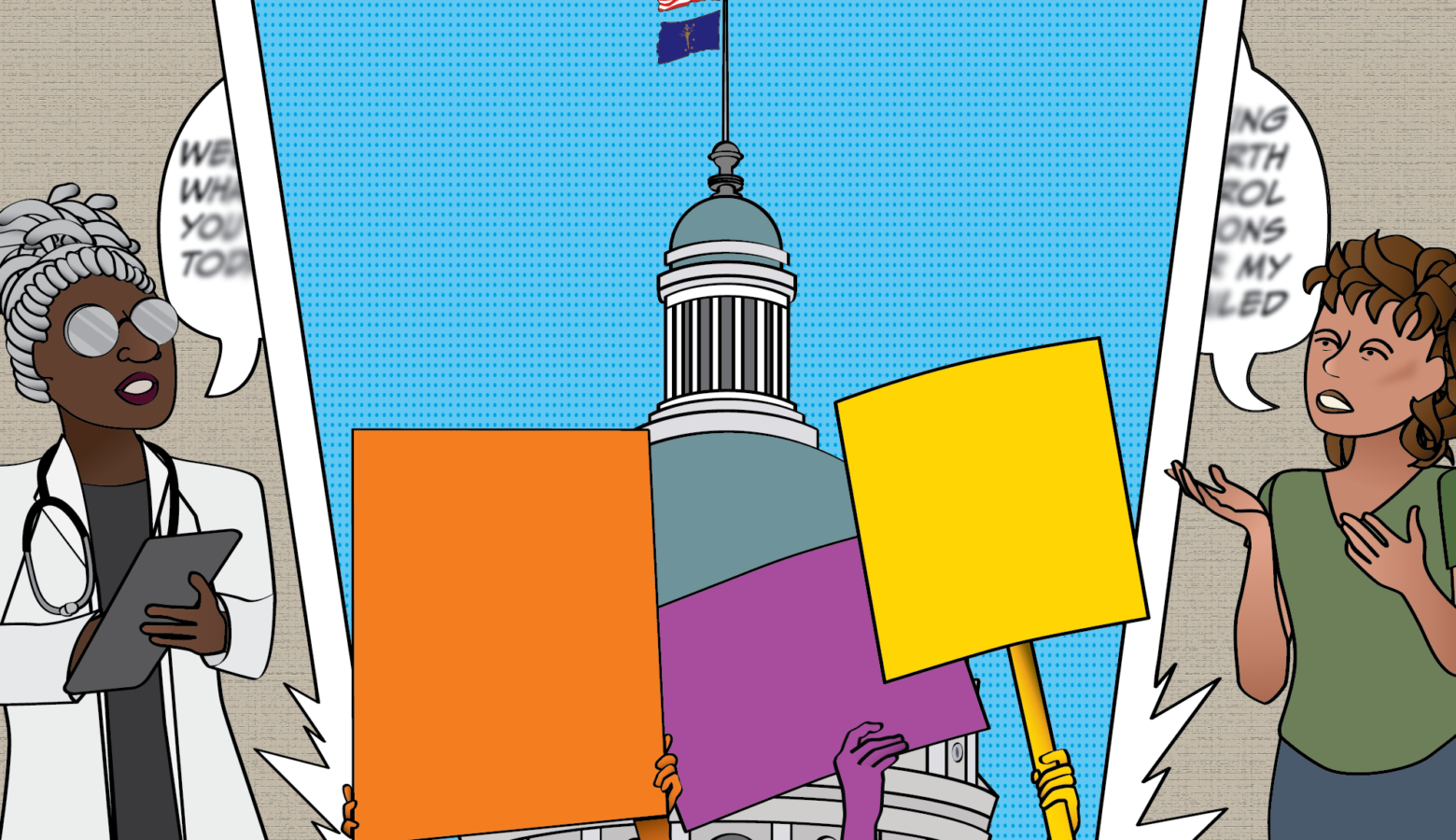Providers, patients work to navigate access to care in near-total abortion ban’s first year

Jess Marchbank helps run the Hoosier Abortion Fund for All-Options Pregnancy Resource Center. For years, she would brace herself every morning before going through applications submitted to the fund. She was used to being overwhelmed by requests for support from people seeking abortions.
When the near-total abortion ban took effect about a year ago, Marchbank expected the volume of requests for help to at least remain consistent.
“When I logged in on August 1st and there were no new messages, no applications at all, I didn’t feel relieved at all,” Marchbank said. “I felt scared and frustrated.”
The fund used to receive hundreds of calls each month, but since the ban it averages a little more than 100. Marchbank said it’s not that fewer people need abortion care — it’s that people don’t understand the law, leading to fear and confusion.
“They don’t know that it’s perfectly legal to talk about getting an abortion, to go to another state to get an abortion, to get help getting one,” Marchbank said.
Indiana’s near-total abortion ban went into effect nearly one year ago, cutting off access for most Hoosiers. In the last year, patients have encountered new challenges and barriers to what many providers consider an essential part of OB-GYN care. Now, advocates, patients and providers are navigating access to care under the ban.
The law only allows abortion care under a few narrow exceptions. These include if there is a “serious” threat to the pregnant person’s health or life; if there’s a lethal fetal anomaly up to 20 weeks post-fertilization; and in cases of rape or incest, but only up to 10 weeks.
But even those are difficult to navigate. Marchbank said when a patient may qualify to receive care in Indiana, in her experience, they tend to proactively choose to go out-of-state.
“They may be able to access an abortion that is a fraction, like a tiny fraction of the cost and not have to jump through nearly as many of those hoops that they would if they tried to get one in the state,” Marchbank said.
However, getting care out-of-state comes with its own challenges. The fund typically covers the cost of an appointment. But it has had to work with other funds, such as the Chicago Abortion Fund or Midwest Access Coalition, to address additional barriers that come with having to travel for care, such as gas, housing and child care.
Marchbank said this increases the amount of money the fund has to give to each person and increases how much time it takes to manage each case.
Advocates also have to navigate different requirements or restrictions in surrounding states when they connect people to care. For example, Ohio requires a 24-hour waiting period while Illinois doesn’t. Michigan doesn’t have a waiting period either, but Marchbank said it has less overall funding available for people coming from out-of-state.
“We spent a lot of time kind of walking people through other clinic options that may be better suited to them,” Marchbank said.
It’s not just patients and advocates navigating the ban. Dr. Caroline Rouse, a maternal fetal medicine specialist at IU Health, said the law has vague, non-medical language that can be confusing for providers, too.
“Patients’ ability to have health care is made a lot more difficult when it’s not just me and the patient in the exam room — it is also the legislature of the state of Indiana,” Rouse said.
Some hospital systems have created specific resources to help providers make these difficult considerations around care. For the IU Health system, this is where the “rapid response team” comes in.
“The rapid response team is kind of happening in the background,” Rouse said. “It is available to clinicians within IU Health who have a question that requires immediate response for a patient sitting in front of them – questions related to abortion. There are also non-urgent question answering venues, through email or other ways.”
Rouse said IU Health started developing the team after the U.S. Supreme Court released the Dobbs decision, which ended the constitutional right to abortion that had been upheld for decades.
If a provider is unsure if something qualifies as a legal abortion, they can reach out. The team includes representatives from the system’s clinical, legal and ethics teams. It’s available 24 hours a day, seven days a week.
Rouse is one of the clinical responders. She said the team offers providers answers about what’s allowed under the law and IU Health policy.
“As complete a response as one can have in the setting of a law that – again – is very, very vague and non-medical,” Rouse said.
For providers, these resources can help them give patients the best care that’s allowed under the law. But that doesn’t eliminate the fear entirely.
Rouse said people have even declined offers to work in her division because of the law.
“Moving to a state where there are criminal penalties for providing evidence-based reproductive health care is not something that a lot of people want to entertain,” Rouse said.
That affects more than just access to abortion care. A national study found that fewer medical school graduates applied to residency programs in states with bans or restrictions on abortion. Indiana saw more than a 9 percent drop across all specialties.
Dr. Julie Tillman, an OB-GYN and the vice chair of the Indiana American College of Obstetricians and Gynecologists, said the state already has a shortage of providers and this law makes it harder to maintain Indiana’s workforce.
“We’re seeing fewer residents that are training in Indiana. And then we’re also seeing subsequently fewer people are sticking around in Indiana,” Tillman said. “Many of them are choosing to practice outside of Indiana once they graduate.”
In addition, Tillman said some existing providers are dropping the obstetrics part of their practice or leaving the state entirely.
And Indiana providers aren’t alone in trying to navigate what care looks like under abortion bans. Currently, 14 states have abortion bans with narrow exceptions. Another six states ban abortion beyond six weeks.
Dr. Stella Dantas, president of the American College of Obstetricians and Gynecologists, said providers across the country are trying to decide what care they can give patients and when.
“We give patients options about, based on their condition, what they can do and talk to us about the risks and benefits,” Dantas said. “Now, your hands are tied and you’re told like, ‘You can’t do this until this gestational age or you can’t do this at all.’ How do you care for patients?”
READ MORE: Indiana’s near-total abortion ban leads doctors out-of-state for training
Join the conversation and sign up for the Indiana Two-Way. Text “Indiana” to 765-275-1120. Your comments and questions in response to our weekly text help us find the answers you need on statewide issues and the election, including our project Civically, Indiana.
Dantas said for providers that choose to leave, they have to uproot their lives and find somewhere new to practice. For the providers that choose to stay, Dantas said the conditions created by restrictions or bans can contribute to provider burnout.
“The clinicians left behind in those states — now you have the same population, and you’re trying to take care of that population with a smaller number of clinicians,” Dantas said.
The consequences of having a smaller number of providers can range from providers being on-call more often to a clinic having to close due to a lack of staff. Dantas said access to care in the community can suffer in those cases.
Providers in Indiana, like Rouse and Tillman, are trying to navigate how access to care has changed in the past year.
“This abortion ban is really having a severely negative effect on our workforce in Indiana, but we’re doing the best that we can right now,” Tillman said.
It may take some time before the data reflects the full impact of the near-total ban. For now, providers and advocates continue to connect people to the care they need despite the challenges created by the law.
Abigail is our health reporter. Contact them at [email protected].


